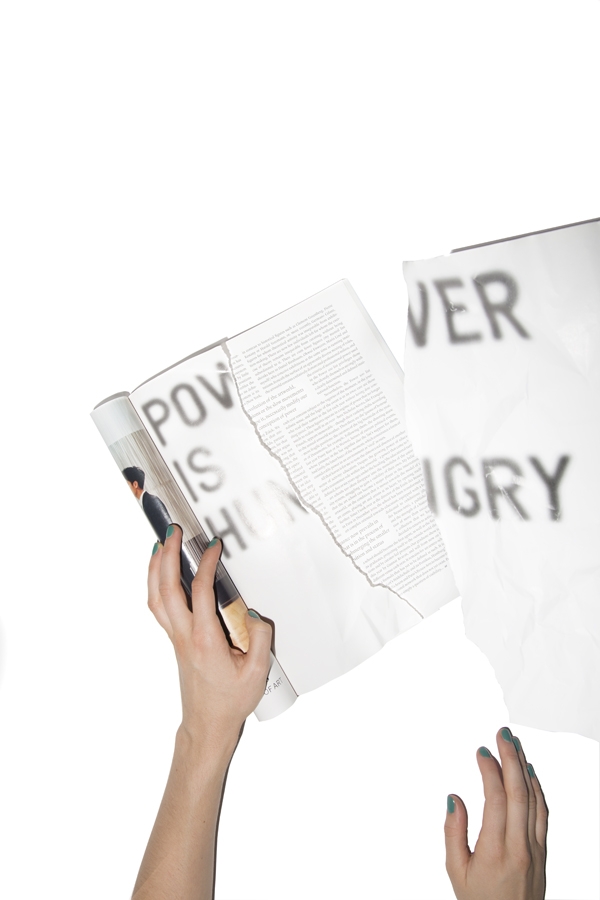The weak sunlight of the October afternoon is fading as I skip down the strange rampy bit outside Tate Modern, my Rick Owens wool and white silk lace-up coat keeping me snug against the early autumn chill. I wink at the security guy, who looks suspiciously like the handsome director of one of the only leading galleries to have a drive-thru McDonald’s within 100 metres of its doorstep. Inside, people mill around for the regular Friday evening late opening, looking up at the Richard Tuttle fabric sculptures. In among them I start to pick out people I think I recognise.
Lurking near the ticket booths are three figures, who despite their disguises of red Marni woven wool capes and Berghaus Windstopper balaclavas could well, with their mix-and-match physiques, be a legendary American family of collectors. Then again they could just be three oddly shaped punters buying tickets for the Polke show upstairs. The friendly-looking Chinese man serving them behind the ticket desk has the pleased look of someone whose paintings recently set auction records for work by an Asian artist, and the bespectacled elderly gentleman with a mane of grey hair next in the queue seems to be clutching his copy of October: The Second Decade a little too tightly.
And then, around them, figures appear who seem like ghosts from the distant past. A handsome Indian gentleman of a certain age in a cravat looks angry and gestures at the void of the Turbine Hall’s space. “It was me here once!” he shouts at a bald man in a pinstripe suit with the sharp features befitting a former Swiss ambassador. A serious German man who could be an art-book publisher chats to two smart British gentlemen art dealers with identical receding hairlines and holding copies of Tim Noble & Sue Webster’s tome British Rubbish. All of them look at me as I walk purposefully to the centre of the Turbine Hall. Bang on cue, a crew made up of technicians who have worked for Reena Spaulings and Bernadette Corporation lower a stage entirely constructed from copies of Antonio Gramsci’s Prison Notebooks, and I clamber onboard.
“Power is up its own ass! Where’s Christoph Büchel now? Does anyone read e-flux any more?”
“My friends!” I begin, tapping on the Shure 55SH vintage-style microphone. “Noam Chomsky once said that there’s no point in reading a book if you let it pass before your eyes and then forget about it ten minutes later. And the same is true for the ArtReview Power 100. You were once on that list! And then, suddenly, you were not, cruelly discarded by the whims of art power.” The Indian gentleman has had enough. He leaps onstage, pulls off his cravat and waves it in the air. “When the world is mine, then you all will be the 99.9%!” he yells at the crowd as the Bernadette Corporation guys lower a painting that seems to be a reworking of Courbet’s L’Origine du Monde with a chap’s equipment up his own backside. I grab the microphone back from the Indian fellow.
“Power is up its own ass! Where’s Christoph Büchel now? Does anyone read e-flux any more?” The old guy holding the October anthology sheepishly puts his hand up. The Bernadette Corporation people set free a flock of doves, a number of whom fly straight into the Tuttle sculptures and immediately combust. The two British art dealers and the American collector family join us onstage and start belting out the chorus to the Jennifer Lopez and Pitbull World Cup anthem. “Ole ole ole ola!” they sing. “From the streets of Cairo to the Arab Spring, to Occupy Wall Street to here, Occupy Power 100! Put on your goggles and let’s pretend we’re in Hong Kong!” I shout above the harmonising, waving around a tear gas canister. I’m just about to put on my comedy Jeffrey Deitch spectacles and unveil my plan for hacking into the Power 100 website in order to restore all these great art figures around me to their rightful place when I feel the crowd’s attention drift upwards. There on the balcony are various high-net-worth individuals applauding. “Hold on,” says one of the British dealers, “isn’t that the Middle Eastern and North Africa Acquisitions Committee?”
“Could be, or perhaps it’s the Photography Acquisitions Committee,” replies his colleague. “Whatever, we’ve got to get up there.” In the confusion, a man who I had assumed was a once-prominent Middle Eastern collector slips off his Isabel Marant keffiyeh, revealing himself to be ArtReview’s dastardly editor, who, whispering “wrong cover” through gritted teeth and having a quick glance around to check if there are any ‘sponsors’ he might need to ‘silence’, rips the cock-up-butt painting to the floor. “It’s because of precisely this kind of cockup”, he says to an early supporter of Damien Hirst, waggling his fingers to put speech marks round the last bit, “that you people are no longer on the list”, before disappearing in a puff of purple smoke. The Indian chap grabs his cravat from the floor. “Excuse me,” he says, “I think that’s the International Council up there. Or perhaps it’s a group of private museum holders desperately seeking Western intellectual validation. Or perhaps, perhaps… it is the great man himself. I have no idea but I must go meet and greet.” As he runs, his Church’s monkstrap shoes tear the remains of the painting from its frame, and bits of it wrap around his ankle. He bounds towards the stairs, joining the crowds thronging upwards, climbing on each other’s heads and trampling the ass-cock into the dust of the concrete floors.
This article was first published in the November 2014 issue
